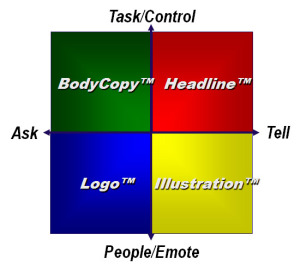Our personal likes and dislikes determine how we expect others to behave toward us.
When these expectations are met, we are more comfortable and more interested in doing business together. Different personality profiles have different likes and dislikes. People are most comfortable relating to and working closely with others when their needs are being met, and when they are safe within their own comfort zone. Agencies that modify their behavior to make clients more comfortable improve relationships and enhance their chances of retaining clients. Before agency behavior can be modified, the expectations of each personality profile must be identified.
Profile Clients (Ask or Tell, People or Tasks)
- The Headline client wants results! Now! Give them options.
- The Bodycopy client wants process. Ask how. Give them a scorecard.
- The Logo client wants relationships. Always about we. Give them more time.
- The Illustration client wants new, big ideas. Always about the wow factor! Give them inspiration.
Agencies that fully utilize profiling will be versatile with all four personality profiles, and therefore will be able to make other people comfortable, adapt to the needs of others, negotiate better and empathize more completely.
A Two-Way Relationship Beneficial to Both Parties.
Many agencies see every discussion on advertising creative work as a test of agency leadership. The agency reacts to any client suggestions in an inflexible manner as if the client’s suggestions on ways to “improve” the creative are not the client’s prerogative. Such an approach can turn all differences of opinion on a creative assignment into an agency-client confrontation. Such an operating philosophy is damaging to long-term retention.
Accept the truth that the vast majority of work turned out by agencies can be considered “good advertising.” By definition, this means the advertising works. Every now and then agencies will turn out work that can be classified as a “Big Idea.” By definition this means a significant piece of advertising that will have a major impact on a client’s business. Big Ideas are worth fighting for. Good advertising usually isn’t. Smart agencies understand that with “good advertising” there are different points of view about what is “good,” what will “work,” and what each person “likes.” If this is the case, then why risk damaging the agency-client relationship by fighting all the time over “good advertising?” The objective with “good advertising” is to solve a client’s problems in a friendly and cooperative manner.
Consider taking the point of view that fighting over “good advertising” is counterproductive to retention and save the fights for “Big Ideas.” Here agency leadership and toughness is required to get the concept approved and to let the client take a risk in order to achieve a large gain.
Note that such a strategy does not mean the agency tries any less to do “great” on every assignment. But such an approach is in step with the real world where clients often see an agency’s so-called “great” advertising as merely “good” and therefore they may have an opinion, point of view or suggestions about it. With such flexible strategy the agency objective is to achieve a strong two-way relationship in a friendly environment, not to force the agency’s way every time. In this flexible strategy the agency reserves the right to fight hard for those occasional “Big Ideas” that by definition will have a significant impact on the client’s core business. These “Big Ideas” are judged to be worth fighting for and perhaps even risking the agency-client relationship. “Good advertising” is not worth this risk.
Focus On Controlling the Agency-Client Relationship.
Profiling improves chemistry by better understanding client expectations. Their expectations are based on personality profiles that we can identify. Use profiling to strengthen the agency-client relationship. Be sure the agency’s culture, defined as “the way we do things around here,” puts a high priority on retention and not on agency inflexibility.
The objective of our HighGear training is to teach these skills. Once you understand profiling, you will be able to describe the expectations of each personality profile. You will be able to maintain control over the agency-client relationship. You will be able to keep clients happy and accounts profitable without having to jump through hoops. Clients will like you.
More tips for better agency-client relationships:
- Organic growth is so simple, why don’t we do more? Here are some rules to help you find more ways to grow your agency.
- Clients are always looking for more ideas: Tips for Unleashing Ideas
- Stop discounting the goods and services we provide! Negotiation Rules of the Road
- We all have stories about the client that got away: The 8 Steps of Negotiation
- 7 ways to energize your team: Overhaul Account Management
- Is there a secret to keeping clients happy? Agency Clients: You No Longer Care
Rejection photo by Myst-Moon


